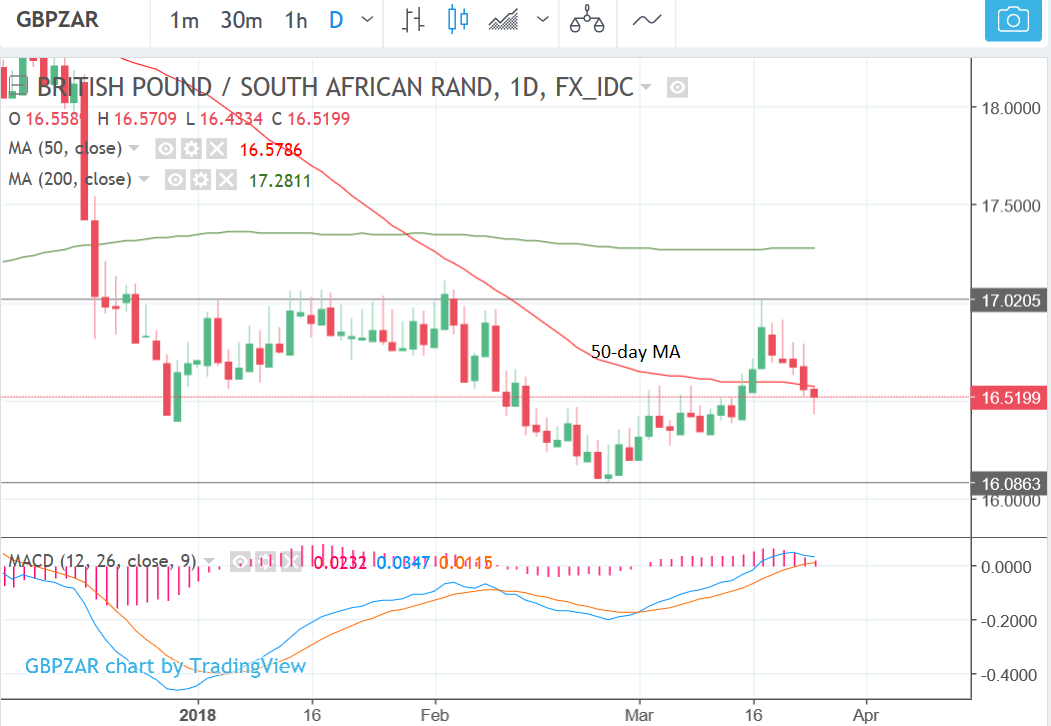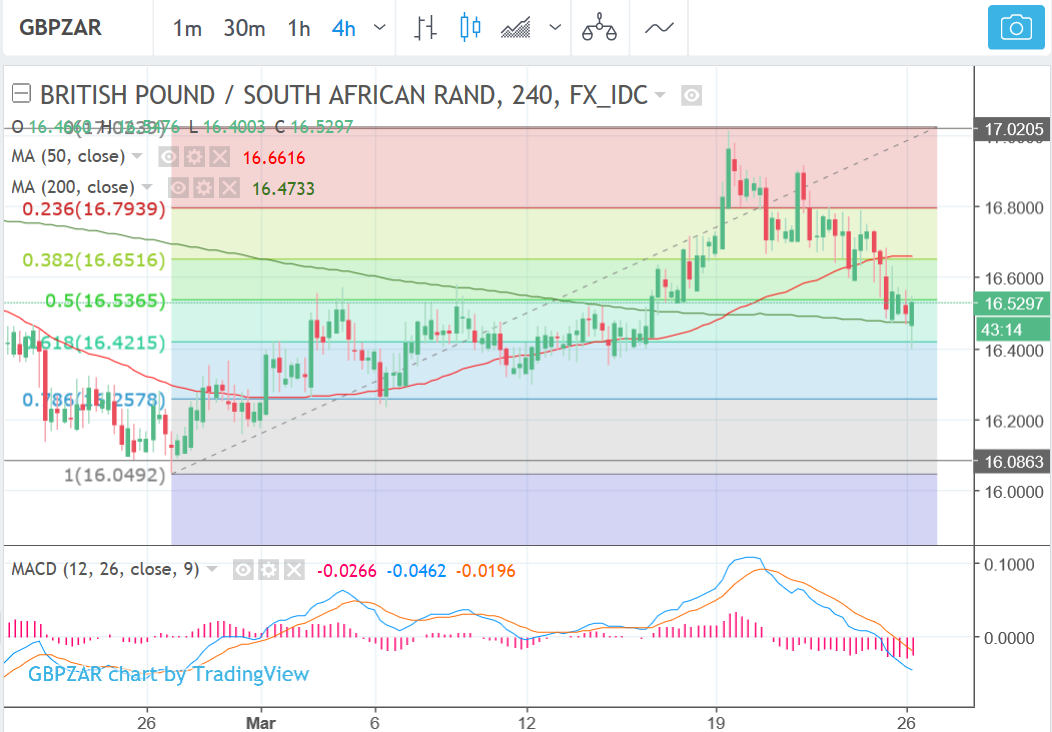Pound-to-Rand Rate Forecast in Week Ahead
- GBP/ZAR has fallen to a key level at the 50-day MA
- The outlook is still neutral with arguments both for more upside and downside carrying weight
- The South African Resserve Bank is expected to cut interest rates on Wednesday

© thanasak, Adobe Stock
GBP/ZAR appears to be weakening again as the South African (SA) Rand strengthens following its positive assessment by rating agency Moody's.
The news SA averted a credit rating downgrade on Friday has helped give the Rand a fillip against counterparts.
GBP/ZAR has fallen in line with this recent bout of Rand strength and is currently trading at 16.59.
But it has also just found support at a key level in the form of the 50-day moving average (MA) which could put a floor under the exchange rate preventing further downside.
Thus overall we remain neutral the pair in the week ahead.
Large moving averages act as formidable obstacles to the trend because many investors use them as their primary decision-making tool and this increases selling pressure around them.
Sometimes wholesale reversals occur at the level of MAs too.
It is difficult to deduce whether a reversal might occur on GBP/ZAR and lead to a move higher but there is a possibility it will, however, at the moment the short-term downtrend remains marginally bearish.
There is a clearly a case for a reversal higher happening in the short-term, but, given there is no corroborating evidence from price action, even on the smaller 4hr chart (see above) we cannot be confident the exchange rate will rise yet.
Get up to 5% more foreign exchange by using a specialist provider to get closer to the real market rate and avoid the gaping spreads charged by your bank when providing currency. Learn more here.
Data and Events to Watch for the Rand
Friday's news that Moody's investor service decided not to downgrade South Africa's credit rating to 'junk' came as a huge relief to investors and helped support the Rand. Indeed Moody's actually upgraded their outlook from negative to stable.
Moody's said they expected that "the previous weakening of South Africa's institutions will gradually reverse under a more transparent and predictable policy framework," adding, "The recovery of the country's institutions will, if sustained, gradually support a corresponding recovery in its economy, along with a stabilization of fiscal strength."
Whether gains endure, however, is debatable given the currency faces downside risks from a central bank meeting on Wednesday, March 28, where it is widely expected that the South African Reserve Bank (SARB) will cut interest rates. Inflation has been dampened by the strong currency which has made foreign imports cheaper, and it is falling inflation which is expected to lead to a decision to cut rates from 6.75% to 6.50%.
Interest rate cuts generally make a currency weaker as they lessen inflows of foreign capital which prefer higher rates, which increase returns.
"Surprisingly low inflation of late has fuelled rate cut expectations. Overall, this argues for muted rand appreciation in case of a positive rating verdict," says Commerzbank analyst Elisabeth Andreae.
As such there is a risk that any gains the Rand is currently making from averting a credit rating downgrade may be lost on Wednesday at the SARB meeting, reinforcing our overall neutral outlook.
Data and Events to Watch for the Pound
Overall it is a relatively quiet week for the Pound on the calendar and the most likely source of volatility will probably be the ongoing Brexit debate.
The Pound strengthened last week after a transitional agreement was agreed by the EU in Brussels, which will now see the UK extend its stay by 21 months after the March 2019 deadline, on special terms, whilst a comprehensive trade deal is hammered out.
Brexit headlines are of course impossible to predict as they are generated by politicians and we will be monitoring the newswires for any potential points of interest.
From a purely hard data perspective, the main release is the third estimate of Q4 GDP on Thursday at 8.30 GMT, although the consensus sees little chance of a change from the second estimate of 0.4% growth quarter-on-quarter.
"The more significant interest for next week’s publication will come from the national accounts detail released at this time," says Investec of the GDP release. This will include revisions to data on household income and personal finances in general, which affect overall consumer spending, the biggest driver of growth for the economy.
Should growth be downgraded unexpectedly we would certainly expect a soggy end to the shortened week for the Pound.
Current account data for Q4 is also out on Thursday, March 29, at 09.30, and is forecast to show the deficit widening to -24.0bn from -22.8bn previously.
Traditionally the current account was always seen as a major influence on currency levels but now there appears to be little empirical evidence of a link, so we do not see much volatility arising from this release.
The CBI Distributive Trade Survey for March is out on Wednesday, Mach 28 at 10.00 GMT and will provide the latest data on the retail sector.
"Launched in 1983, this widely followed survey covers questions on sales, orders, stocks, general business situation, employment trends and internet sales," says the CBI website.
Other March data includes Gfk Consumer Confidence, which forecasts to remain at a -10 reading the same as February.
Investec, however, sees a chance of a lift to -8 in March because of rising wages, less job uncertainty, easing inflation, the agreement of a Brexit transition deal and "the uncharacteristically “Tiggerish” Chancellor at his inaugural Spring Statement.
Other data in the week ahead includes mortgage approvals on Monday at 8.30, Nationwide house prices on Thursday at 6.00 (watch for a negative result as this would make two negative months in a row and be bearish for Sterling); business investment on Thursday at 8.30, consumer credit at the same time and mortgage lending also at the same time.
Get up to 5% more foreign exchange by using a specialist provider to get closer to the real market rate and avoid the gaping spreads charged by your bank when providing currency. Learn more here.


